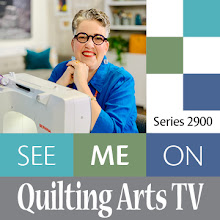I am always amazed at the difference it makes when I take the time to photograph my work outside, in natural light. This photo shows the same piece I posted about last night. I finished it after dark, so I took some photos inside, under an Ott light, which simulates daylight. Here is that photo:
Isn’t the difference incredible? Even if the Ott light gets close to the real colors in the piece, it still produces a flat look. By shooting outside, in daylight, but either very early in the morning or very late in the afternoon, I can get much nicer subtle shadows that show off the indentations from the quilting. Can you see how much more dimension the two photos below have because they were shot outside?
Good lighting and good photography in general are very important if you want to enter your quilts in big quilt shows. If you talk to people who have screened and juried these shows, they will tell you amazing stories about out-of-focus shots, distorted shots, or photos with visible people/hands/feet showing. If you send in these photos, you usually don’t stand a chance of getting in.
When I was working on my book, I needed to be able to take good photos whether it was day or night, cloudy or bright. So I borrowed high-quality lights from my friend, Patrick Schneider, who is a professional photographer. I set up a mini photo studio inside my house, and I worked with C&T Publishing’s photography team to get better results. It made all the difference in the world. All the how-to photos were consistent, with good color balance and lighting.
If you don’t have the time/money/patience/desire to set up a photo studio in your home, or if you don’t have the money to pay a professional photographer, here are five basic tips:
1. Shoot your piece outside, in early morning or late evenings, when shadows are longest.
2. Some people advise shooting on a cloudy day, but I get the best results when the sky is clear.
3. Put your pieces flat on the ground, and use a ladder or step-stool, if needed, to get high enough that you can shoot straight down. (Very large quilts require a different approach, like hanging them on the side of a building, or off a deck railing.)
4. Place your quilt on a neutral-color sheet, or some other background that will not be distracting.
5. Consider your camera. Some camera’s lenses tend to distort the image, creating “fisheye” bulges. I have one camera I bought specifically because it was advertised as not doing this, and I do get much better results with it.
If you want to learn more, check out the fabulous information on Holly Knott’s website. I also highly recommend Gloria Hansen’s book Digital Essentials for people who want to know how to save, resize, or manipulate their digital images, or prepare images to submit to quilt shows.
















